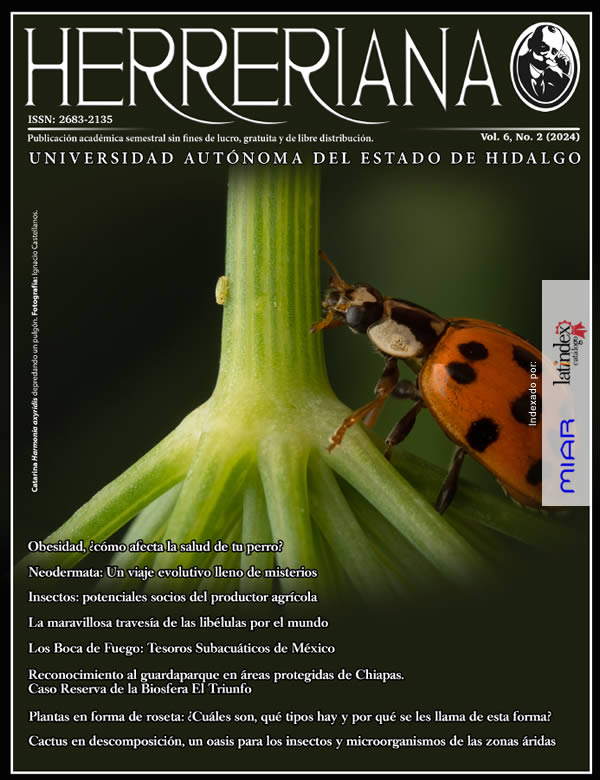Decomposing cactus, an oasis for insects and microorganisms in arid lands
Abstract
Cacti present a high diversity and are an emblematic group of the Mexican landscape. These plants provide food and shelter to many animals in desert areas, but as their tissues decompose, they offer a new source of resources for a very particular fauna, the entomofauna (insects and other arthropods). This work describes the entomofauna that depend on the decomposing parts of several species of cacti for their survival, as well as their possible role in the decomposition of these plants and their interactions.
Downloads
References
Anoop, E. V., Ajayghosh, V., Nijil, J. M. y Jijeesh, C. M. (2014). Evaluation of pulp wood quality of selected tropical pines raised in the high ranges of Idukki District, Kerala. Journal of Tropical Agriculture, 52 (1), 59-66.
Bernal-Salazar, S. y Terrazas, T. (2005). Wood anatomical variation of Neobuxbaumia tetetzo: A columnar Cactaceae. Journal of Arid Environments, 63 (4), 671-685.
Blackwell, M. (2017). Made for each other: ascomycete yeasts and insects. The fungal kingdom, 945-962.
Bravo-Avilez, D., Rendón-Aguilar, B., Zavala-Hurtado, J. A. y Fornoni, J. (2014). First report of Cactophagus spinolae (Coleoptera: Curculionidae) on two species of Stenocereus (Cactaceae) in Central Mexico. Revista Mexicana de biodiversidad, 85 (3), 972-974.
Bravo-Hollis, H. y Sánchez Mejorada, H. (1978). Las Cactáceas de México. Tomo I. Universidad Nacional Autónoma de México.
Castrezana, S. y Markow, T.A. (2001). Arthropod diversity in necrotic tissue of three species of columnar cacti (Cactaceae). Canandian Entomologist, 133 (3), 301.
Chávez-Sifontes, M. y Domine, M. E. (2013). Lignina, estructura y aplicaciones: métodos de despolimerización para la obtención de derivados aromáticos de interés industrial. Avances en Ciencias e Ingeniería, 4 (4), 15-46.
Clausen, C. A. (1996). Bacterial associations with decaying wood: a review. International Biodeterioration & Biodegradation. International Biodeterioration & Biodegradation, 37 (1-2), 101-107.
Díez, D., Urueña, A., Piñero, R., Barrio, A. y Tamminen, T. (2020). Determination of hemicellulose, cellulose, and lignin content in different types of biomasses by thermogravimetric analysis and pseudocomponent kinetic model (TGA-PKM Method). Processes, 8 (9): 1048.
Fogleman, J. C., Starmer, W. T. y Heed, W. B. (1981). Larval selectivity for yeast species by Drosophila mojavensis in natural substrates. Proceedings of the National Academy of Sciences, 78 (7), 4435-4439.
Fogleman, J. C. y Danielson P. B. (2001). Chemical interactions in the Cactus Microorganism-Drosophila model system of the Sonoran Desert. American Journal of Zoology, 41, 877-889.
Foster, J. L. y Fogleman, J. C. (1994). Bacterial succession in necrotic tissue of agria cactus (Stenocereus gummosus). Applied and Environmental Microbiology, 60 (2), 619-625.
Ganter, P. F., Peris, F. y Starmer, W. T. (1989). Adult life span of cactophilic Drosophila: interactions among volatiles and yeasts. American Midland Naturalist, 331-340.
Guerrero, P. C., Majure, L. C., Cornejo-Romero, A. y Hernández-Hernández, T. (2019) Phylogenetic relationships and evolutionary trends in the cactus family. Journal of Heredity, 110 (1): 4–21.
Korotkova, N., Aquino, D., Arias, S., Eggli, U., Franck, A., Gómez-Hinostrosa, C., Guerrero, P. C., Hernández, H. M., Kohlbecker, A., Köhler, M., Luther, K., Majure, L. C., Müller, A., Metzing, D., Nyffeler, R., Sánchez, D., Schlumpberger, B. y Berendsohn, W. G. (2021). Cactaceae at Caryophyllales.org – a dynamic online species-level taxonomic backbone for the family. – Willdenowia, 51, 251–270.
Maceda, A., Soto-Hernández, M., Peña-Valdivia, C. B. y Terrazas, T. (2018). Chemical composition of cacti wood and comparison with the wood of other taxonomic groups. Chemistry and Biodiversity, 15 (4), e1700574.
Martínez-Falcón, A.P., Marcos-García, M.A., Díaz-Castelazo, C. y Rico-Gray, V. (2010). Seasonal changes in a cactus-hoverfly (Diptera: Syrphidae) network. Ecological Entomology, 35, 754-759.
Martínez-Falcón, A.P., Marcos-García, M.A. y Moreno, C. (2011). Temporal shifts and niche overlapping shifts and niche overlapping in Copestylum (Diptera, Syrphidae) communities reared in cactus species in a central Mexican scrubland. Ecological Research, 26, 341-350.
Martínez-Falcón, A. P., Marcos-García, M. A., Moreno, C. y Rotheray, G. (2012). A critical role for Copestylum larvae (Diptera, Syrphidae) in the decomposition of cactus forests. Journal of Arid Environments, 78, 41-48.
Martínez-Falcón, A. P., Yáñez-Espinosa, L., Flores, J., Morales-Jiménez, J. I. y Ramírez-Hernández, A. (2023). A review of the entomofauna associated with decaying cacti in New World deserts. Annals of the Entomological Society of America, 116 (5), 243-260.
Mauseth, J. D. y Plemons, B. J. (1995). Developmentally variable, polymorphic woods in cacti. American Journal of Botany, 82 (10), 1199-1205.
Myburg, A.A., Lev-Yadun, S. y Sederoff, R.R. (2013) Xylem Structure and Function. In: Encyclopedia of Life Science. American Cancer Society.
Pimienta-Barrios, E., Zanudo, J., Yepez, E., Pimienta-Barrios, E. y Nobel, P.S. (2000). Seasonal variation of net CO2 uptake for cactus pear (Opuntia ficus-indica) and pitayo (Stenocereus queretaroensis) in a semi-arid environment. Journal of Arid Environments, 44, 73-83.
Rotheray, G. E., Marcos-García, M. A., Hancock, G., Pérez-Bañon, C. y Maier, C. T. (2009). Neotropical Copestylum (Diptera, Syrphidae) breeding in Agavaceae and Cactaceae including seven new species. Zoological Journal of the Linnean Society, 156 (4), 697-749.
Starmer, W. T. (1982). Analysis of the community structure of yeasts associated with the decaying stems of cactus I. Stenocereus gummosus. Microbial Ecology, 8, 71-81.
Zavala-Hurtado, J. A. y Díaz-Solís, A. (1995). Repair, growth, age and reproduction in the giant columnar cactus Cephalocereus columna-trajani. Journal of Arid Environments, 31, 21-31.
Copyright (c) 2024 Ana Paola Martínez Falcón, Laura Yáñez-Espinosa, Joel Flores, Jesús Israel Morales-Jiménez, Alfredo Ramírez-Hernández

This work is licensed under a Creative Commons Attribution-NonCommercial-NoDerivatives 4.0 International License.










